浮华与市井──十八世纪西方版画
“这是最好的时代;这是最坏的时代”,狄更斯如此描述十八世纪末的欧洲。对于一些人来说,日子过的很愉快,对另一些人来说,这是个艰苦岁月。伏尔泰(1694-1778)认为人类不过是“在一点泥土上吞食彼此的昆虫”。卢梭(1712-1778)质问为什么“人是生而自由的,但却无处不在枷锁之中?”作家和哲学家密切关注他们的年代,并想知道如何才能改善它。包括伏尔泰在内的一些欧洲人把目光移至其他国家——尤其是中国——寻找可供西方借鉴的实用的智慧。
当新兴的中产阶层日益状大,使得他们加强了对于物质享受的欲望,及艺术品去装饰他们生活的渴求。在此之前,只有贵族或者宗教组织才能消费得起艺术品。但是,由于版画制作的发明,使更多人可以欣赏得到一些著名画家制作(或复制自他们作品)的蚀刻版画。例如法国画家安东尼•华托(1684-1721)、法兰索瓦•布雪(1703-1777)、让•巴蒂斯•西美翁•夏尔丹(1699-1779)及让•奥诺雷•佛拉格纳尔(1732-1806)。一群杰出的版画创作者在同一时代涌现:吉勒斯•德玛图(1722-1776)、路易斯•马林•邦尼特(1736-1793)、查尔斯•梅尔基奥尔•德柯蒂斯(1753-1820)、第伯柯尔特(1755-1832)。他们当中有些人发明创造出美丽的彩色版画,并试图让它们看起来像是蜡笔画或水彩画。其他艺术家,诸如让•米歇尔•莫罗(小)(1741-1814)和让•巴普蒂斯特•乌德里(1686-1755),为德•拉封丹(1621-1695)、雷蒂夫•德•拉•布雷东(1734-1806)及卢梭(《爱弥儿》或《论教育》和《新爱洛伊斯》)的书制作了令人赞叹的插图。
十八世纪一些杰出的版画出自意大利、西班牙如乔瓦尼•巴蒂斯塔•蒂耶波洛(1692-1770), 安东尼奥•卡纳莱托(1697-1768)和弗朗西斯科•戈雅(1746-1828)这些画家之手,他们一边为贵族客户作画作为他们的主要收入来源,一边利用蚀刻技术作为表达他们个人观点与想象的方式。相比之下,意大利的乔瓦尼•巴蒂斯塔•皮拉内西(1720-1778)和英国的威廉•霍加斯(1697-1764)两位当红画家,为了谋生而制作巨大的对开本尺寸的雕刻版画以迎合广大的观众。皮拉内西向来罗马的观光客提供一个令人印象深刻的永恒之城的图像,而霍加斯则应合英国口味,将幽默和说教糅合到的艺术作品中。
在这次展览中有许多十八世纪著名西方艺术家的作品。第伯柯尔特创作的《公众散步在皇宫花园里》和托马斯‧罗兰森(1756-1827)创作的《沃克斯霍尔花园》也许说得上是这世纪中两幅最著名的蚀刻版画。这次也展出了一些不甚知名但极好的画家的作品,例如让•雅克•德•布瓦修(1736-1810),他生于里昂一个贵族家庭的,却选择描绘低下阶层的生活。提及由埃德姆‧布沙东(1698-1762)等艺术家创作的题为“巴黎的呼喊”的系列版画,历史学家丹尼尔‧罗什写道︰“在君主制衰退的年代……,小说及叙事画证明了当时对于展示一般人民的现实生活有着强烈的需要”(《启蒙运动中的法国》)。那个年代伟大的版画家们给我们留下了很多值得纪念的图像,反映出西方近代史的开端──1789年大革命之前欧洲上流社会和下层民众的生活。
High Life and Low Life: 18th Century Western Prints
“It was the best of times, it was the worst of times, ”Charles Dickens wrote of late 18th-century Europe. For some people, life was very pleasant; for others, it was an age of severe hardship. Voltaire (1694-1778) wondered if men were no more than “insects devouring one another on a little atom of mud.” Jean-Jacques Rousseau (1712-1778), asked how it is that “Man is born free, and is everywhere in chains”? Writers and philosophers looked at their age closely and wondered how it could be improved. Some Europeans (including Voltaire) looked to other countries--China especially--to find a practical wisdom that might be applied to the West. As a newly emerging middle class developed, so too did the desire for material comforts and for fine arts to adorn their lives. In former times, only the nobility or the religious orders could afford works of art; but the invention of print-making permitted many people to enjoy etchings made by (or copied from) famous painters such as the French artists Antoine Watteau (1684-1721), François Boucher (1703-1777), Jean-Baptiste Siméon Chardin (1699-1779), and Jean-Honoré Fragonard (1732-1806). A group of distinguished print-makers thus arose during the same era: Gilles Demarteau (1722-1776), Louis-Marin Bonnet (1736-1793), Charles-Melchior Descourtis (1753-1820), Philibert-Louis Debucourt (1755-1832), among others. Some of them created beautiful color prints, which were intended to look like crayon drawings or watercolors. Other artists, such as Jean-Michel Moreau le jeune (1741-1814) and Jean-Baptiste Oudry (1686-1755) made stunning illustrations for books by La Fontaine (1621-1695), Rétif de la Bretonne (1734-1806), and Rousseau (Emile and La Nouvelle Héloïse). Some of the greatest prints of the century were made by painters in Italy and Spain such as Giovanni Battista Tiepolo (1692-1770), Antonio Canaletto (1697-1768), and Francesco Goya (1746-1828) who--while creating works for noble clients as their principal source of income--at the same time, found in the etching technique a means of expressing their private thoughts and fantasies. By contrast, two popular artists--the Italian Giovanni Battista Piranesi (1720-1778) and the British
William Hogarth (1697-1764)--made their living by producing large folio-sized engravings for a wide audience. Piranesi provided visitors to Rome with unforgettably dramatic images of the Eternal City, while Hogarth catered to the British taste for artworks that provided humor mixed with moral lessons. In our exhibition, we have works by many celebrated Western artists of the 18th century. Debucourtʼs La Promenade Publique and Vauxhall Gardens by Thomas Rowlandson (1756-1827) are perhaps the two best-known etchings of the
century. We also have works by wonderful artists who are not as well known, such as Jean-Jacques de Boissieu (1736-1810), who was born into an aristocratic family in Lyons but who chose to depict scenes of humble life. Referring to the
series of prints titled The Cries of Paris--created by artists such as Edme Bouchardon (1698-1762)--historian Daniel Roche writes, “As the monarchy declined ..., [n]ovels and narrative paintings demonstrated an intense need to display the reality of ordinary peopleʼs lives” (France in the Enlightenment). The great print-makers of the age have given us memorable images of the low life and the high life that existed in Europe just before the Revolution of 1789 at the start of modern history in the West.



 Arthur M. Sackler Museum of Art and Archaeology at Peking University
Arthur M. Sackler Museum of Art and Archaeology at Peking University